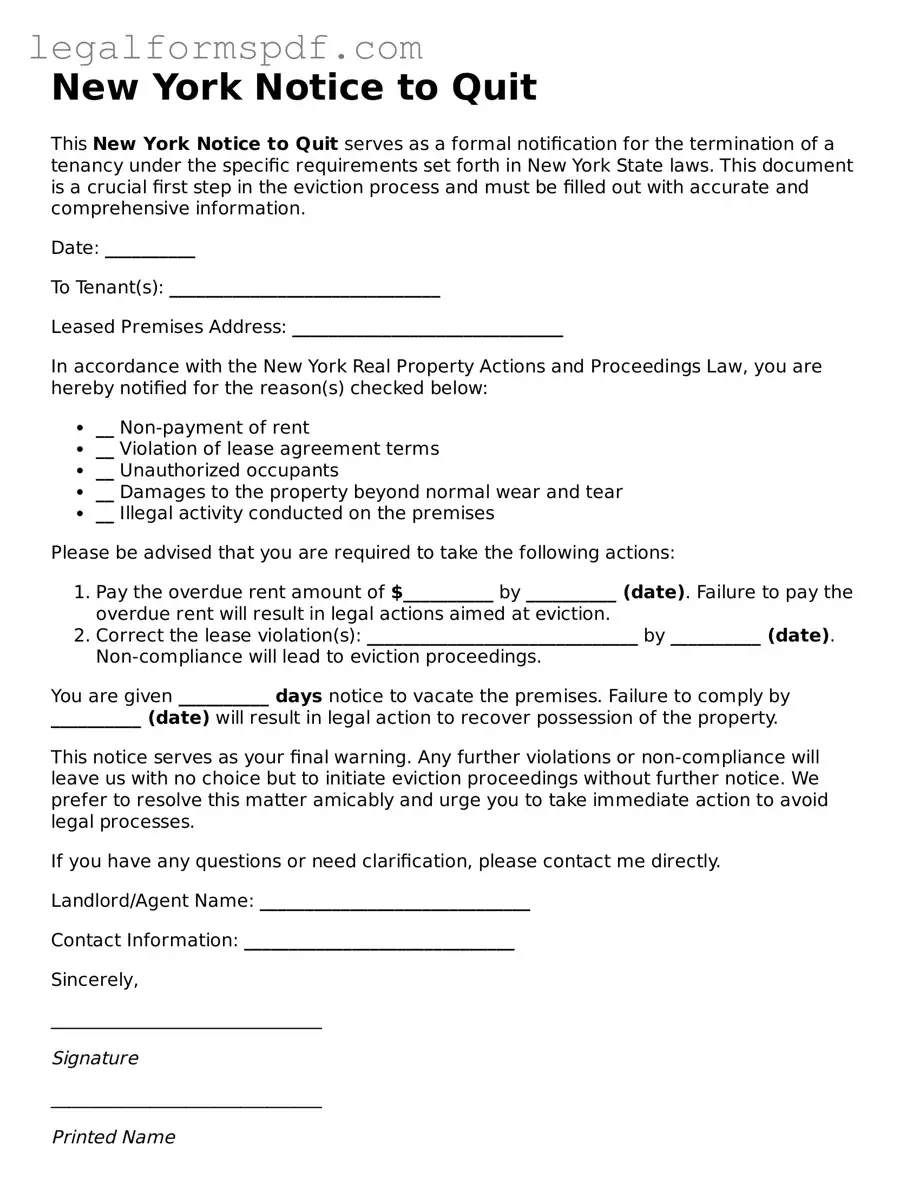The New York Notice to Quit form is closely related to the Eviction Notice, as both serve to inform tenants that they must vacate a property. An Eviction Notice, much like a Notice to Quit, outlines the reasons for eviction, such as non-payment of rent or violation of lease terms. It's the critical first legal step a landlord must take to reclaim their property, setting the stage for potential legal proceedings if the tenant does not comply.
Similarly, the Lease Termination Letter bears resemblance to the Notice to Quit because it also communicates the end of a rental agreement. However, a Lease Termination Letter may be used under less contentious circumstances, such as the natural expiration of a lease or a mutual decision to end the rental relationship earlier than planned. It still marks the conclusion of the tenant's right to occupy the given premises.
A Rent Increase Notice parallels the Notice to Quit in its function to inform tenants about changes to their rental agreement, specifically, an increase in rent. Though its purpose is not to terminate the lease but to adjust the terms, it requires landlords to provide tenants with advance notice of the change, similar to how a Notice to Quit notifies tenants of the need to vacate.
The Cure or Quit Notice is a specific type of eviction notice that, like the New York Notice to Quit, is used in situations where a tenant has violated lease terms. This document gives the tenant a chance to "cure" the violation, such as by paying overdue rent or ceasing disruptive behavior, before having to "quit" the premises. It's a blend of offering a second chance and warning of potential eviction.
Another related document is the Pay Rent or Quit Notice, which is a direct ultimatum for tenants who have not paid their rent. It mirrors the Notice to Quit in its finality and immediate demand for action, giving tenants a clear deadline by which they must pay the owed rent or face eviction proceedings. This notice is strictly regarding rent payment issues.
The Three-Day Notice to Quit is a variant that demands tenants vacate the premises within a very short timeframe, typically due to serious lease violations or illegal activities conducted on the property. It is similar to the broader Notice to Quit but is more urgent in nature, reflecting the severity of the tenant's misconduct or the immediate need for them to leave.
Demand for Compliance or Possession is a document that, like the Notice to Quit, addresses lease violations but focuses on giving the tenant an option to correct the issue before moving forward with eviction. If the tenant fails to comply, the landlord may proceed with reclaiming possession of the property. This notice balances between offering a remedy and preparing for legal eviction.
The 30-Day Notice to Vacate serves a similar purpose to the Notice to Quit by informing tenants that they must leave the rental property, typically at the end of a monthly rental period. It's commonly used when landlords do not wish to renew a month-to-month lease and requires tenants to prepare to move out within the given timeframe, ensuring both parties have sufficient notice.
Unconditional Quit Notice is a stern document that leaves no room for negotiation, demanding that tenants vacate the property without offering an opportunity to rectify their lease violations. It shares the decisive tone of a Notice to Quit, typically reserved for situations involving ongoing issues or severe non-compliance by the tenant. This type of notice is a last-resort measure to reclaim property.
Last but not least, the Notice of Lease Violation is an informative document that, akin to the Notice to Quit, alerts tenants to breaches of their lease agreement. Although it does not immediately demand vacating the property, it warns of potential eviction if the issues are not resolved. It serves as a preliminary step before more concrete actions, like the Notice to Quit, are taken to enforce lease terms or reclaim the premises.
